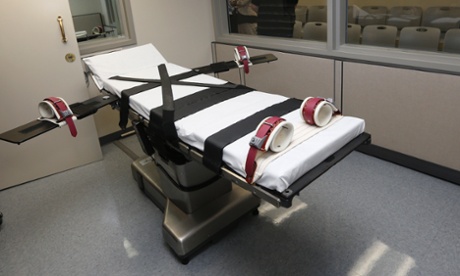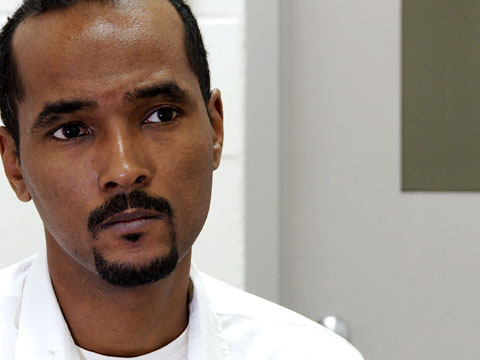The relentless pursuit of “non-stop executions” by a rump of US death penalty states is exposing prison staff to extreme levels of psychological and physical stress, according to traumatized corrections officers who are appealing for help.
Though capital punishment is generally on the wane in America, with only five states carrying out executions last year, those states that remain active are showing a renewed determination. In some states, the pace of judicial killings is now so intense that prison guards are kept in an almost permanent state of readiness, with mock executions staged on a rolling basis.
In Oklahoma, officers at the state penitentiary in McAlester, which houses the death chamber, are so stretched by the schedule of 25 executions set in 2022 by the Republican-controlled state that the state’s own attorney general and the head of the prison service have appealed to the courts for a more staggered approach. They have requested that the gap between executions be widened from 60 to 90 days, so far to no avail.
The unprecedented move to try to cool the pace of executions followed a joint letter to the state’s attorney general, Gentner Drummond, from nine former senior corrections officials. They warned that staff were being subjected to “lasting trauma” and a “psychological toll” that included post-traumatic stress disorder, alcohol abuse and distress due to the “non-stop executions”.
Justin Jones, the director of Oklahoma’s department of corrections between 2005 and 2013, was one of the letter’s nine authors. He told the Guardian that a pending execution affected not just those employees actually deployed in the death chamber but every worker in McAlester.
“It’s not just those working the IVs and injections. You’ve got case managers, correctional officers, staff working with surviving victims, others working with the family of the soon-to-be executed,” Jones said.
With an execution set every 60 days, mock executions – in which the entire execution process is put through a dress rehearsal – are conducted constantly, within earshot of the prisoners and staff offices. Hearing the procedures can be profoundly triggering.
“It affects your mental state when it becomes so routine,” he said.
The culture of the prison is such that staff very rarely talk about their emotional responses. “We don’t talk about it. Correctional officers are public servants on the lowest salaries in state government, and they get home at the end of the day and just absorb it,” Jones said.
In his eight years as corrections director, Jones himself witnessed 27 executions. As the top prison official, it was his job to receive the governor’s final go-ahead and then call the death chamber and issue the order for the execution to begin.
He continues to be haunted by the experience, and has made a point of forgetting the deceased prisoners’ names to protect himself. “I can remember their faces, and a little bit about their last words. But I intentionally have not remembered names.”
Jones fears that when staff are put under such extreme pressure they are more likely to make mistakes. That’s an especially sensitive subject in Oklahoma, given the state’s parlous track record of botched executions.
Judicial killings were halted in the state for six years after the gruesome execution of Clayton Lockett in 2014. He writhed and groaned on the gurney for 43 minutes.
Despite such concerns, calls for the brakes to be applied to Oklahoma’s breakneck execution schedule have so far failed. An appeals court judge responded to the request to extend the space between killings to 90 days by telling staff to “suck it up” and “man up”.
The comments have dismayed and angered current and former staff. “You really need to be careful what you say when you are talking about people who are doing the ultimate that government ever asks anyone to do – kill another human being,” Jones said.
Bobby Cleveland, executive director of Oklahoma Corrections Professionals, which advocates for prison staff, said that members were outraged. “They are really mad that a judge would make that kind of comment. He doesn’t know what it’s like to be a corrections officer.”
The chair of the criminal justice and corrections committee in the state assembly, Justin “JJ” Humphrey, was also scathing about Judge Gary Lumpkin’s remarks. “To talk about executing somebody, and just ‘suck it up’ – that’s a pretty callous statement.”
Humphrey worked as a prison officer for 20 years, and has observed the emotional wear and tear. “Anybody that thinks that executing somebody is no problem has not been a part of the process,” he said.
Staff and death row inmates often spend years in close proximity. More than half of all prisoners on death row have been there for more than 18 years, according to the Death Penalty Information Center.
Over that time, a cold-blooded murderer can mature and change. That was the case with Brian Dorsey, 51, who was sentenced to death in Missouri for killing his cousin and her husband.
More than 60 former and current corrections officers wrote to Missouri’s governor, Mike Parson, in January imploring him to spare Dorsey’s life. Describing themselves as generally in favour of the death penalty, they said that the ultimate punishment was not appropriate for a prisoner who had grown to become “one of the most trusted in the institution” and a “model inmate”.
Missouri nonetheless went ahead with Dorsey’s execution earlier this month.
Tim Lancaster worked in Missouri corrections for 27 years, retiring in 2021. He got to know Dorsey very well over an eight year span; the inmate was the designated prison barber and would cut his hair twice a month.
“Brian just kept to himself, never got into trouble. He was polite, respectful. No way was he the worst of the worst.”
Lancaster said the act of sitting in a barber’s chair with his back to a death row inmate bearing a sharp pair of scissors was in itself a sign of how completely Dorsey had reformed himself. “There’s some on death row who would never get near the scissors, let alone cut somebody’s hair. But you learn their behaviors, and I got to trust Brian more and more.”
Lancaster said that when he heard the news that Dorsey had been killed he felt let down. He has since talked to current corrections staff and found them to be similarly riled up. “That’s bullshit, shouldn’t have happened,” one current corrections officer told him.
“You’re working with a prisoner for 10 years, you’ve interacted with them every single day, and you can feel they’ve changed,” Lancaster said. “They’ve really rehabilitated, and that’s the department’s goal – to rehabilitate offenders.”
But in Dorsey’s and in many other cases, an ironic moment is reached when corrections officers, whose main duty it is to rehabilitate prisoners, are told to kill a rehabilitated prisoner.
“All of a sudden they flip the switch, and now it’s like: ‘OK, we’re going ahead and killing them,’” Lancaster said. “There has to be an underlying effect from that, without a doubt.”











